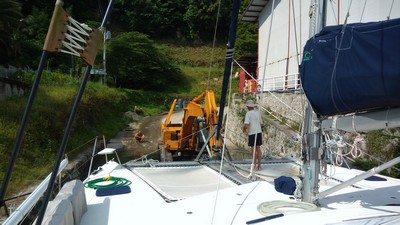
The primary impetus for the haulout, so soon after our last one, was continuing problems with the lower half of our SD20 saildrives. When we bought the boat, the saildrives had evidence of pretty severe galvanic corrosion, but we loved the rest of the boat so much that the alarm bells didn't ring loud enough. (We did get 3 years of use out of them.). But when we were in Indonesia last year, we continued to struggle with issues related to the corroded lower assemblies.
Dave thought that we could just buy the outer aluminum housing, and that would fix our primary problem. But Yanmar doesn't sell just the outer housing. So in September we bit the bullet and ordered 2 SD20 full lower assemblies. After checking with the Yanmar dealer in the Philippines, and pushing for a quote and delivery for nearly 2 weeks, we finally got a price (outrageous) and delivery "we don't know when we can deliver them". So, we finally ordered 2 new units from Mastry Engine Center in Florida, the SE USA Yanmar dealer.
We ordered the heavy bulky items to be shipped to my sister's house in Atlanta, so we could immediately arrange to ship them sea freight, so they'd be in the Philippines when we arrived back in December. But the customs laws were changing in the Philippines, and in September, when we arrived in Atlanta, it was uncertain whether we could ship them duty free. So then we decided we'd have to take them back in our luggage!!
By December when we arrived back at my sister's house to organize ourselves to fly back to the Philippines, we had received clarification on the shipping issue and decided to go ahead and ship them sea freight rather than trying to get them there in our fly-in luggage. In the end, they arrived in the Philippines intact, at a very reasonable rate, no duty required. But it took nearly 3 months for them to reach us in Davao. (We knew this when we made the decision to ship vs carry).
Meanwhile we had other projects to keep us busy. The biggest was "transom extensions" (aka enlarged swim platforms). We cruised last year in Indonesia with Ocelot, who had done this on their boat. Because we are "over design weight", the steps down the aft end of our two hulls are lower in the water than designed. The bottom step was always "a-slosh" resulting in rapid algae growth. No matter how often we scrubbed the top surface of the bottom step, it was always very slippery (and looked frightful too).
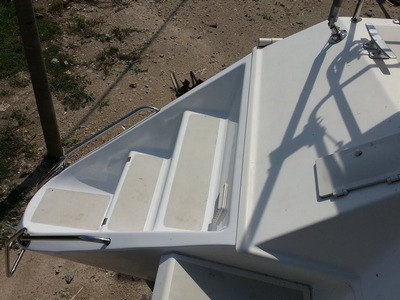
So Dave and the marina carpenters designed and constructed a 1 foot extension on the stern on each hull that raised the lowest step to the height of the next higher step (about 6"). This did two things--make a nice wide, flat "landing area" on the stern; and raised the bottom step around 6", so it is no longer "a-slosh" when sitting at anchor in normal conditions. It also extended our waterline length another foot, but I'm not sure this is significant in a catamaran. It also added buoyancy to the aft end of the boat, so we weren't "dragging ass" so much.
The extensions were fashioned from boat construction foam and honeycomb, plus a little fiberglass and epoxy. The result was a very professional looking job and fabulous in form and function. Here is one picture of the end result:
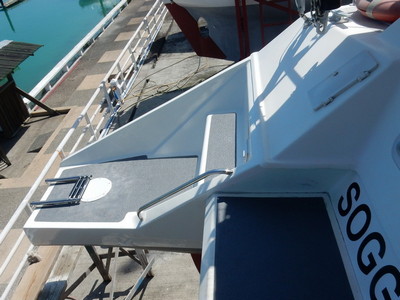
For a full set of photos of the extensions under construction, see this photo album: Aft Step Extension
A third major project we completed in January, while waiting for the saildrive parts to show up, was to build a big sturdy "helm seat" from the leftover foam we had from the extension project. The boat came with a low-end post-mounted wobbly plastic captain's chair. It wasn't high enough for me to see the bow of the boat (or ahead of the boat) while sitting down, and it was uncomfortably wobbly in a sea. That meant that I'd have to stand while driving (or sit in cheap wobbly plastic chairs we have on the wing deck). We had already done emergency repairs on it to make it last as long as it had.
Our friends on Tackless Too had a nicely crafted stainless steel "captains chair". custom made by a welding shop. It was gorgeous, but expensive, and heavy. Dave knew the marina carpenters could make us a great chair with our leftover foam. And they did!
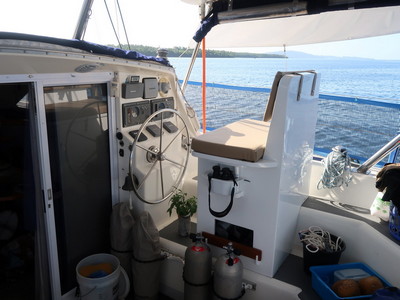
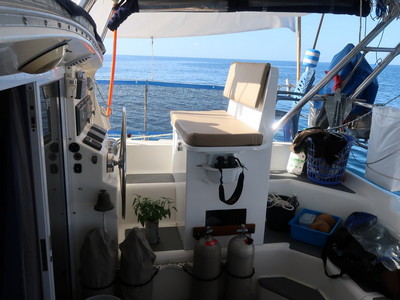
It was designed to be wide enough that the two of us can sit there comfortably and see what's going on at the same time. It is a fabulous addition to both comfort and safety underway. And though it looks very heavily built, the construction foam makes it very light. Plus we designed in ample storage for all our cockpit "stuff".
Meanwhile, my job was "Chief Purchasing Officer", "Expediter" and "Technical Research Officer". I spent a bunch of time on the computer sourcing both parts and information, arranging shipping, and tracking shipments. Of course, once the saildrives arrived, we found we were missing a couple of critical gaskets. So I had to find a source for them and get them to the Philippines "quickly". We ended up with 3 "rush" shipments in the end, for which we used a Philippine company called Johnny Air. They have offices in NY and California where you can send a package, and they handle the Customs clearance in Manilla and get it to us in Davao in a timely fashion (about 10-14 calendar days, usually). Neither DHL or FedEx are recommended for rush shipments of goods into the Philippines, as stuff gets tied up in Customs, sometimes for weeks and for hundreds of extra dollars in Customs and agent fees. Not sure how JohnnyAir manages, but they do.
If Dave needed to know how to do anything on the engines, or other projects, I searched online forums and Youtube for just the right information, and collated it all for him to use.
I also had a number of maintenance projects in the sewing arena. Our dinghy cover first purchased in Colombia in 2008 needed some more TLC. The sunbrella is good as a cover, but it does't hold up to the rugged use of the dinghy. Lots of plastic chafe protection added in various places, plus I had to completely rebuild the aft end of the tube covers. I also completely rebuilt/reinforced the mainsail cover/Stackpack. It needed a new 20-foot zipper plus needed a flap to cover the zipper so the UV doesn't get to it. And patches and restitching in several places. I added a second layer of cloth on the top flap of the stackpack, to provide more UV protections, and some reinforced drain holes in the bottom, so rain water wouldn't stand inside the cover.
My biggest project, which I put off and put off, because I knew it was going to be very difficult to do a good job, was to finish the cockpit enclosure I had started the year before. Before, I had done the easy part--roll-down sides--straight lines--easy peasy (but still took 2 weeks to finish). And the year before that, I had adapted the original front "window" part to our new hardtop. What was missing was the corner pieces. The way our cockpit is, there are complex curves in the corner everywhere, and I just couldn't figure out how I was going to shape the thing. It was a daunting project. But it had to be done, and there is no "canvas place" in Davao that I could hire to do it. Fortunately, my sewing friends on s/v Carina had told me that I should be using patterning material for jobs like that. So one of the shipments we got from the US was some more clear vinyl for the windows, and the patterning material and double-sided tape. Wow, that stuff is so easy to work with--after watching a 15 minute video by Sailrite, I was an expert. My corner windows turned out really well (for an amateur job).
Fortunately for me, because my sewing list was so long, there's a nice Filipino tailor with a sewing machine near the marina, and Dave gave him all the easy projects (the smaller stuff, covers, etc). Ariel the Tailor does great work. He did the cushions for the helm chair (above), as well as new covers for our Man Overboard Module, and the rope reel hanging off the stern rail, new windlass cover, and a "line bag" for the reefing lines under the boom.
Dave and his Filipino helper, Alex, also took the lids off all 14 hatches on the boat, and cleaned up everything, checked the locking handle mechanisms, checked the gaskets, and fixed the two leaky hatches.
Dave and Alex also replaced the 8 below-water through-hulls. The old bronze and stainless ones were looking pretty shaky, and a friend on another St. Francis warned us that his had crumbled in his hands when he tried to remove them. A couple of ours did the same! We replaced them with new composite through-hull and ball valve fittings from Tru-Design in NZ (sourced via Defender and shipped via JohnnyAir).

Dave and Alex also did a bunch of preventive maintenance on the Yanmar engines, including rebuilding the raw water pumps, and mounting a matched set of new alternators with fancy electronic alternator regulators (designed to be compatible with a Lithium battery bank in the future). They also rewired a bunch of the start battery circuit to add an "always on trickle charge" mechanism for the start battery.
So, it was a very fruitful haulout. We were scheduled to launch March 15 during an appropriate high tide window. But we didn't get the final gaskets until a couple of days before that, and Dave and Alex still had to put the engines together!! Amazing that we could go in on the 17th, just 2 days late!! (Dave is AMAZING).
Whew! It's great to be floating again!!
Phew !
ReplyDelete